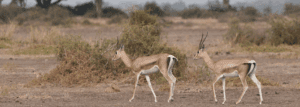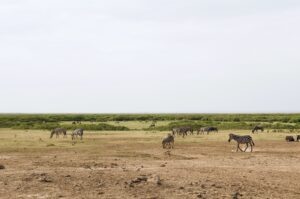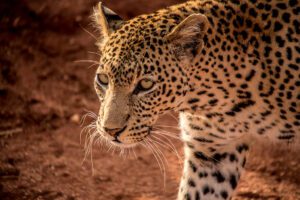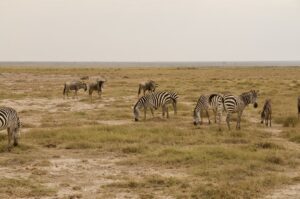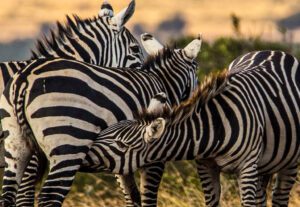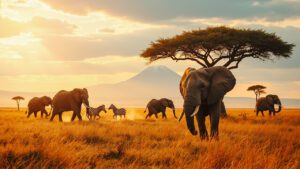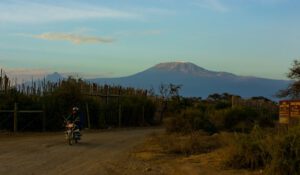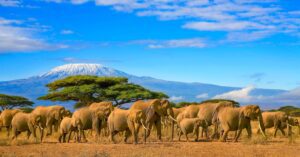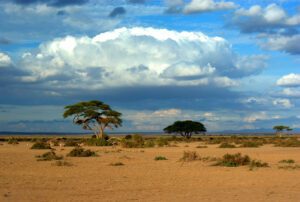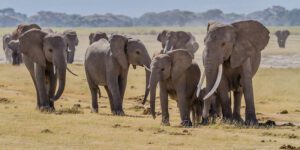What is Amboseli Observation Hill?
Amboseli Observation Hill, also referred to as “Noomotio” in the local Maasai language, is a notable viewpoint located within Amboseli National Park in Kenya. This small yet popular observation point offers stunning panoramic views of the scenic landscape. Unlike much of the park, which is predominantly flat and consists of open savannah grasslands, Observation Hill provides an elevated vantage point, making it one of the key attractions in the Amboseli area.
The hill itself has volcanic origins, formed by ancient geothermal and volcanic activity in the region hundreds of thousands of years ago. From this viewpoint, visitors can gaze out over Amboseli’s vast expanses, including seasonal swamps, and on clear days, even catch breathtaking views of Mount Kilimanjaro, Africa’s highest mountain. The aerial perspective from Observation Hill enhances the experience of wildlife watching, as it allows for fantastic wildlife views of the park’s diverse inhabitants.
What truly makes this spot special is that Amboseli National Park is renowned for its significant population of free-ranging elephants and a variety of other wildlife like zebras, giraffes, and hippos. This elevated point offers a rare opportunity to observe these animals in their natural habitat, enriching the overall safari experience.
Where is Observation Hill located within Amboseli National Park?
Observation Hill is situated within the southwest region of Amboseli National Park, making it a prime spot for wildlife watching and scenic views. Amboseli National Park itself is located in southern Kenya, near the border with Tanzania, and is renowned for its incredible wildlife encounters and views of Mount Kilimanjaro. If you look at a map of the park, you’ll find Observation Hill near the middle of the park’s wetlands, which is ideal for travelers exploring the Amboseli area.
The hill is surrounded by Amboseli’s iconic swamps and grasslands, with the Enkongo Narok swamp nearby being one of the park’s key wetland areas. This attracts a variety of wildlife, including elephants, buffaloes, and hippos. The location of the hill serves as a perfect natural observation point in a flat landscape, allowing visitors to enjoy fantastic wildlife views. Many tourists use the hill as a pit stop during their observation hill tours or safaris to get a better perspective of the park’s beauty.
To access Observation Hill, most visitors drive through the network of dirt roads within the park, which are specifically set up for safari vehicles. Because the hill is located close to some of the most visited areas, such as the swamps where elephants often graze, it is easy to incorporate it into a day of exploring the park.
What is the significance of Observation Hill in Amboseli?
Observation Hill holds great significance because it offers visitors an elevated space to truly appreciate the beauty and ecological diversity of Amboseli National Park. This area is unique because, despite being a dry region, it has rich wetlands and marshes, fed by underground water streams originating from Mount Kilimanjaro’s melting snow. As a scenic viewpoint, Observation Hill acts as the best place to see how these ecosystems blend together.
The hill unlocks a 360-degree view of the park, allowing visitors to witness the coexistence of wetlands, savannahs, and wildlife like elephants, buffaloes, and flamingos in their natural habitats. Having a chance to see the animals from above provides a new layer of appreciation, you can observe herds of animals moving across the Amboseli plains or watch as they drink from the waterholes.
Culturally, the area around Observation Hill is significant to the local Maasai people, who have lived in harmony with this region for centuries. The Maasai use the term “Noomotio” to describe the hill, and it holds a place in their history and stories, though most of the significance today is more ecological than cultural.
Lastly, Observation Hill gives visitors a unique and iconic view of Mount Kilimanjaro, especially during sunrise or sunset when the light highlights the mountain’s snowy peaks. This makes it a favorite location for both tourists and photographers. Its blend of practical use, historical context, and fantastic wildlife views make it a must-visit landmark in the park.
What can visitors see from the top of Observation Hill?
From the top of Observation Hill in Amboseli National Park, visitors can enjoy breathtaking, panoramic views of the entire park. It’s like standing on nature’s balcony, giving you a chance to see the incredible diversity that this area is known for. The hill offers a 360-degree view, where you can marvel at the vast open plains, swamps, and marshes below. These wetlands are lifelines for wildlife in the park and are crucial for animals like elephants, zebras, and hippos to survive.
One of the most famous sights from this scenic viewpoint is the view of Mount Kilimanjaro, Africa’s tallest mountain. The hill provides an ideal vantage point to appreciate the snow-capped peak rising behind the park’s grasslands. On a clear day, especially in the morning or late afternoon, the view is absolutely magical, with the majestic mountain appearing almost surreal.
Additionally, visitors can spot herds of elephants, which Amboseli is famous for, making their way across the plains or drinking from the swamps. It’s also common to see giraffes, buffalo, and even predators like lions or cheetahs prowling in the distance. For bird enthusiasts, the wetlands below are home to a variety of bird species, such as flamingos, pelicans, and waterfowl, making it a prime location for birdwatching.
In short, the top of Observation Hill gives visitors the rare chance to feel immersed in the beauty of the African wilderness. It’s a place where the wide landscapes, wildlife, and even the clouds come together in perfect harmony, creating an unforgettable safari experience.
How do you access Observation Hill?
Accessing Observation Hill is relatively straightforward if you’re visiting Amboseli National Park. First, you need to get to the park itself, which is located in southern Kenya near the Tanzania border. Most travelers reach the park from Nairobi, the capital city of Kenya. You can drive to the park (around 4-5 hours away) or take a small plane to the park’s nearby airstrips if you want a quicker, scenic journey that offers fantastic wildlife views.
Once you’re inside Amboseli National Park, observation hill tours are accessible by car, as there are well-maintained dirt roads that lead to it. Visitors usually get to Observation Hill as part of a guided safari tour with a knowledgeable driver who knows the layout of the park. The hill itself has a small parking area for safari vehicles at its base, making it convenient for those eager to explore the amboseli area.
From there, visitors need to climb a short walking trail to the top of the hill. Don’t worry, it’s not a difficult hike! The trail is relatively easy, taking only about 5-10 minutes to reach the summit, even for people with average fitness levels. Just make sure to wear comfortable shoes, as the trail has a few uneven or rocky patches, though it’s nothing too challenging.
If you’re driving your own vehicle or doing a self-guided tour, maps and park signage will help you locate Observation Hill. Local rangers at the park entrance gates are also happy to give specific directions. Because of its central location, Observation Hill is a popular spot, so you’ll likely see other visitors heading there too.
Is Observation Hill a recommended stop for photography in Amboseli National Park?
Yes, absolutely! Observation Hill is one of the best spots for photography in Amboseli National Park. The elevated position of the hill makes it perfect for capturing stunning, wide-angle shots of the park. Photographers love it because the hill provides unobstructed, bird’s-eye views of Amboseli’s diverse landscapes, from the golden savannah to the shimmering swamps. The contrast between the dry plains and the lush wetlands creates unique photo opportunities that you won’t find in many other locations.
One of the biggest highlights for photographers is the chance to capture Mount Kilimanjaro. This iconic mountain provides a dramatic backdrop for photos, especially when it’s framed by herds of elephants or other wildlife below. Early mornings and late afternoons are the best times for photography here because the light is softer, creating more vibrant and colorful images. During these times, the mountain’s peak is often clear of clouds, making it easier to get that iconic shot of Amboseli Lake.
In addition to landscape photography, Observation Hill is excellent for wildlife photography. From above, photographers can spot animals like elephants, zebras, and giraffes moving across the plains. Zoom lenses are a great tool to bring the park’s thriving wildlife into focus from the hill. Birdwatching enthusiasts can also capture shots of flamingos and other birds in the wetlands below, enhancing their safari experience.
If you’re visiting during sunset, the hill offers a magical opportunity for golden-hour shots. The sinking sun bathes the park in warm tones, creating beautiful silhouettes of animals and trees. In short, if you have a camera, whether it’s a smartphone or professional gear, Observation Hill will not disappoint!
What is the historical or cultural importance of Observation Hill?
Observation Hill in Amboseli National Park serves as a vital observation point, providing a scenic view of the vast Amboseli plains. While it may lack deep historical or cultural significance, its geographic and ecological context makes it an essential vantage point for wildlife watching and surveying the park’s diverse ecosystems. This unique elevation allows visitors to appreciate the incredible wildlife encounters that the park offers, particularly the impressive herds of elephants roaming below.
Historically, the Maasai people, indigenous to the Amboseli area, utilized elevated locations like Observation Hill to monitor animal movements and potential threats. This practice was crucial for safeguarding their livestock and planning hunting or herding activities. As such, the hill serves as a reminder of the Maasai’s enduring connection to the land and its wildlife, highlighting their role in conservation efforts.
While Observation Hill may not be a site of sacred rituals, it provides a fantastic wildlife viewing experience and helps visitors understand the relationship between the Maasai and nature. Today, it symbolizes Amboseli’s appeal as a tourist destination, attracting birdwatching enthusiasts and safari-goers eager to explore the park’s breathtaking scenery.
Standing atop Observation Hill allows visitors to witness the harmonious coexistence of humans and wildlife, making it a key attraction in Amboseli National Park. From this elevated position, one can observe the beautiful landscapes and the diverse animals that inhabit them, enhancing the overall safari experience.
In short, Observation Hill is more important for its contribution to understanding the park and its ecosystem rather than having direct ties to specific cultural or historical events.
Are there any specific wildlife sightings associated with the area around Observation Hill?
Yes! Observation Hill is one of the best spots in Amboseli National Park for wildlife viewing, and its surroundings are a hotspot for specific kinds of animals. Since Amboseli is famous for its large herds of elephants, visitors often see elephants grazing or moving across the plains when looking out from the hill. In fact, the shallow lakes and swamps that are visible from Observation Hill serve as watering areas for many species, making it a prime spot to observe animals gathering around.
For example, early in the morning or late in the afternoon, you might spot elephants walking in groups or cooling themselves in the water.
The wetlands near the hill also attract many kinds of herbivores, including buffaloes, zebras, wildebeests, and antelopes. Because prey animals gather near the water, you might also get lucky and see predators in action. Lions, hyenas, or cheetahs could potentially be observed stalking their prey here. The vantage point allows you to not only see individual animals but to grasp the interactions between predator and prey across the wide-open savannah.
Bird watchers also enjoy this area for spotting many bird species that thrive in the park’s wetlands. Flamingos, pelicans, and storks are just a few examples of birds that frequent the swampy areas nearby.
Because the hill’s surroundings are flat and open, it’s easier to spot wildlife here than in denser bushland or forests. This makes Observation Hill a prime location for both casual wildlife admirers and serious photographers. So, whether it’s elephants splashing in the swamp, a lion prowling in the distance, or birds flying overhead, there’s always something to see around Observation Hill!
Is it safe and accessible for all visitors to climb Observation Hill?
Yes, the Observation Hill in Amboseli National Park is generally safe and accessible for everyone, but there are a few things to keep in mind to ensure a pleasant and safe experience for all visitors. The hill is relatively small and not particularly steep, making the climb easy for most people, including children and elderly visitors who are reasonably fit. There’s a clear, defined path to the top, allowing visitors to follow it easily and reducing the risk of getting lost or slipping while enjoying the scenic view of the Amboseli plains.
That said, the path can involve some uneven terrain, so it’s always a good idea to wear comfortable, sturdy footwear like sneakers or hiking boots. Flip-flops or slippery shoes might make the climb harder than it needs to be.
In terms of safety, the area is free from dangerous wildlife close to the walking path up the hill. Animals like elephants and lions generally stay further away in the savannah or by the swamps, which can be comfortably viewed from the top. However, it’s always important to follow park rules, like not wandering off alone or leaving the vehicle except in designated areas, to ensure personal safety during your wildlife excursions.
Visitors should also consider the heat and sun exposure when climbing. Since Amboseli tends to be hot and sunny, it’s crucial to carry water, wear sunscreen, and bring a hat to protect yourself. With basic precautions, Observation Hill offers a safe and rewarding experience for visitors of all ages, making it one of the key attractions in the Amboseli area.
Whether you’re into birdwatching or simply enjoying the incredible wildlife encounters, Observation Hill provides an excellent place to soak in the breathtaking views of Mt. Kilimanjaro and the surrounding landscapes. It’s a fantastic spot for anyone looking to enhance their safari experience in this remarkable national park.
What is the best time of day or year to visit Observation Hill for optimal views?
The best time of day to visit Observation Hill in Amboseli National Park is early in the morning or late in the afternoon. During these times, the lighting creates a beautiful, soft glow over the expansive landscape, making it ideal for photography and breathtaking views. The morning often brings cooler weather and clearer skies, which is great for capturing panoramic shots of Amboseli’s savannah, wildlife, and, most importantly, Mount Kilimanjaro. Late afternoons can also be magical, offering sunsets that bathe the surroundings in rich orange and golden hues, creating a stunning backdrop for both amateur and professional photographers.
The best time of year to visit depends on what you want to experience. Amboseli generally has two distinct seasons: the dry season (June to October) and the wet season (November to May). The dry season is perfect for wildlife viewing since animals congregate around water sources, which are visible from Observation Hill. During the wet season, the landscape becomes lush and green, making it particularly scenic. Visiting after a rainfall might provide rare, misty views of Lake Amboseli, but keep in mind that clouds sometimes obscure the mountain, so choosing a day with clear skies greatly improves the experience.
For example, if you’re visiting in June or July and climb Observation Hill at sunrise, you’ll likely enjoy a crisp, clear view of Mount Kilimanjaro standing tall against the horizon. In contrast, if you visit in December, after some rainfall, expect an explosion of greenery around you , a stark contrast to the arid season but equally mesmerizing. It’s this seasonal and daily variation that makes planning your visit important to maximize the incredible vistas Observation Hill offers.
Are there any facilities or amenities near Observation Hill?
Observation Hill itself is a natural attraction and lacks developed facilities like restrooms, shops, or cafes. This elevated volcanic hill, located within Amboseli National Park, features a basic pathway that visitors can climb to enjoy panoramic views of the Amboseli plains. The climb to the top is short and manageable for most people, but it’s essential to bring necessary items like water, sunscreen, and a hat for protection from the sun while enjoying the scenic view.
Nearby, within the park grounds, you might find some basic amenities at designated picnic sites or rest stops. These facilities are usually designed to offer travelers a chance to take a quick break, refill their water bottles, or enjoy packed lunches. However, these stops are not immediately adjacent to Observation Hill, so you may need to plan accordingly. There are well-maintained lodges and camps within the Amboseli area, but these are further from the hill itself, typically requiring a short drive.
The simplicity of Observation Hill is part of its charm, it’s meant to give you a raw, uninterrupted connection with nature. It’s more about soaking in the serene beauty of the open plain, watching herds of elephants and zebras, and enjoying the view of Mount Kilimanjaro than about built-up conveniences. This observation point allows for incredible wildlife encounters, enhancing your safari experience.
For example, when visiting Observation Hill, you can carry snacks, good binoculars, and a camera since there isn’t a shop or vendor nearby to provide these items. Most visitors use the facilities at their lodge or campsite before heading out to explore the park, including climbing the hill. This focus on minimal intervention ensures the area remains as pristine and natural as possible, making it an excellent place for birdwatching and wildlife watching.



